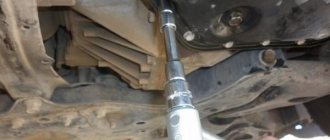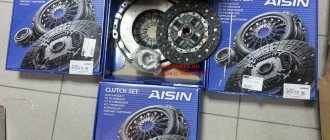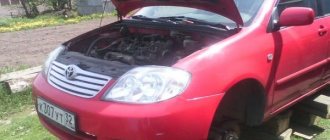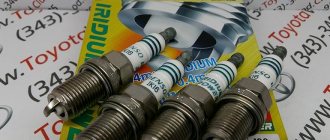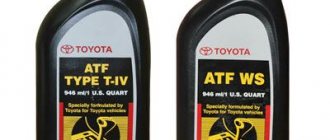02 Apr 20
The robotic gearbox provides the car with a dynamic and at the same time smooth ride. However, the disadvantages of such a mechanism are: unstable operation (the gearbox can arbitrarily switch to the neutral position, increase engine speed at a speed of 130–140 km/h, and also switch to uphill mode when driving on the highway). This instability is caused by the fact that the “robot” mechanism simply freezes. Also, the reason may be the insufficient operating life of such a mechanism. Therefore, the question arises of how to convert a robot into an automatic or manual one with your own hands.
Experience of replacing a robotic gearbox with an automatic Toyota Corolla
Has it ever happened that you needed to replace a robot with an automatic one in a Toyota Corolla? Many car enthusiasts do not like manual transmission, so after the first breakdown they ask to replace it with a regular hydraulic automatic transmission. In this article, I will explain why this happens and give detailed instructions on how to replace the robot with a Toyota Corolla.
Replacing an automatic transmission in a Toyota Corolla: in a service center or on your own
Issues discussed in the material:
Even in such a reliable car as a Toyota Corolla, sometimes the automatic transmission needs to be replaced. Some people immediately turn to service when the gearbox fails, while others prefer to replace this unit with their own hands.
How difficult is this process? What are its subtleties? Even if you are not going to carry out the work of replacing the automatic transmission yourself, knowledge is never superfluous. Someday such information may well come in handy.
Box type
The first Toyota Corolla model was released by a Japanese car manufacturer back in the eighties. After that, it underwent more than 10 restylings. Robotic gearboxes were installed on Toyota Corolla cars with a 150 body and front-wheel drive. Similar machines were produced in 2007 and 2008.
Experienced car owners did not immediately like such machines. Their life resources were significantly underestimated. If with an automatic transmission you could travel 200,000 kilometers, then with a robot, at best, you would travel 120,000 kilometers before the first major overhaul.
Attention! Robots with dry clutches installed on budget front-wheel drive cars are considered especially vulnerable. Such manual transmissions quickly burn out and stop working. Many car owners do not want to install a contract robot. That's why they order a classic automatic machine.
When does it become necessary to replace a robotic gearbox with an automatic one?
Replacing a robot with an automatic occurs when a car enthusiast has a clutch failure. The malfunction appears at 80,000 life resource. Clutch and fork elements are expensive, about 70,000 rubles.
To extend the life of a manual transmission with a wet clutch, change the oil every 50,000 kilometers. Regularly use the mechanical mode of riding the robot. Stop driving aggressively and making sudden starts. This way, you will be able to delay the overhaul of the robot, which is caused by mechanical failures or electrical problems.
Mechanical problems
Most often, a car owner is faced with overheating of a robotic gearbox. Due to high temperatures, the clutch wears out quickly. The robot starts to slip quite often. The car loses torque during the start. When you change gears, there are jerks and jerks.
The robot goes into emergency mode and the machine does not want to move. The release bearing, disk and basket must be replaced. Repairing a robot is expensive. Therefore, if these problems arise, it is better to immediately replace the robot with an automatic one, so as not to kill the engine, and not spend money on repairing faults that you will have to repair when operating a manual transmission.
If you hear a crunching sound when turning on second speed, then the problem lies in a faulty synchronizer. In such a case, I recommend changing the oil and adjusting the gear ratios.
If you are haunted by a constant hum when driving your Toyota Corolla, then you will need to replace the bearings of the primary and secondary shafts.
Electrical faults
In a semi-mechanical automatic transmission, in addition to mechanical faults, electrical problems also appear. For example, if a Corolla car jerks when accelerating, this means that the system is incorrectly configured or the robot has problems with initialization.
If the speed suddenly drops to neutral, it means the manual transmission is overheating. The red light on the dashboard monitor comes on.
In any case, if you are planning to replace the machine with a robot, then you will feel the changes.
Typical problems with automatic transmission, manual transmission Toyota Corolla 150
Most models sold in the CIS are equipped with an automatic transmission. With moderate use, these are comfort, fuel economy, smoothness, acceleration dynamics. Violation of the rules of use leads to breakdowns and technical malfunctions.
Despite the fact that Japanese transmissions are famous for their long service life, ease of maintenance, preventive maintenance should be carried out every 60,000 km. It is also important to observe the interval for changing hydraulic oil and cleaning elements. Typical problems of Toyota Corolla automatic transmission:
- insufficient oil level, as a result of which the planetary gear is not fully lubricated, and the friction force increases;
- mechanical damage, crack, defect, hole in the sealing gasket;
- inaccurate speed switching;
- slight jolts when starting off;
- slippage due to wear of clutches;
- the car starts moving in neutral gear;
- activation of speeds only after the car has slightly warmed up;
- damage to the cooling radiator, which increases the operating temperature, overheating of parts, and accelerates wear of parts.
In each case, the breakdown is identified individually during a comprehensive diagnosis at a service station. Self-inspection is possible, but only with special equipment. As a rule, if the basic rules of car operation are observed and technical inspection is carried out in a timely manner, critical breakdowns do not occur.
Among other modifications of gearboxes, the 4-speed U341F should be highlighted. One of the oldest, but reliable and proven over the years on various Toyota models. The only drawback of the transmission is the failure of the torque converter due to severe overheating.
This does not happen often, only during prolonged slipping, skidding, or ice. Contacting a service station late leads to disastrous consequences - replacing the solenoid block, seals, and electronic control unit.
A modernized version of hydraulics is a robot. This is a manual transmission with electronic control installed. Irregularities in operation lead to “knocking out” of the clutch and slipping. Timely replacement of the unit will significantly reduce maintenance costs, otherwise a major overhaul of the automatic transmission is guaranteed.
The simplest way to independently check the oil level in an automatic transmission:
- put the gear in neutral, start the engine, warm up the car to 40 - 50 degrees. If the car has previously driven more than five kilometers, it should not be warmed up;
- We place the Toyota on a flat viewing platform;
- remove the dipstick from the transmission and wipe it dry;
- lower, remove, check the level. If there is a shortage, we replenish the missing quantity at the service station or on our own if special equipment is available.
The mechanics are checked a little easier - by unscrewing the filler plug on the transmission housing.
Advantages of replacing a manual transmission with an automatic transmission
Robots have the following disadvantages compared to a classic hydraulic machine:
- freezing of servos;
- actuators stop working;
- lack of movement without jolts and jerks;
- incorrect functioning of the gear selector.
All these problems affect driving comfort. That's why experienced car owners try not to buy cars with robots. But, if you really had to do this, it is better to replace it with an automatic transmission.
The benefits of installing an automatic transmission are as follows:
- the machines are reliable;
- repairable;
- have easy gear shifting;
- low cost of parts;
- The manual transmission does not automatically switch to neutral mode.
For example, on a Toyota Corolla, the robot can be replaced with a hydraulic automatic model A240L or U340E.
Write in the comments, have you already changed the robot to an automatic machine on your car yourself?
Recommendations for increasing the service life of automatic transmissions
- systematically warm up the car before each time you leave the garage;
- undergo technical inspection strictly according to the approved schedule. An increase in interval is allowed, but not more than 500 km;
- fill the transmission fluid strictly in accordance with temperature indicators, observing the viscosity coefficient;
- do not exceed the permitted speed limit;
- Avoid slipping and over-gearing. If necessary, keep the tachometer needle in the green - yellow zone, balance the load with rest for the automatic transmission.
This is interesting: Air filter VAZ 2114: where is it located and how to replace it
Instructions for replacing a robot with an automatic one on a Corolla
To properly install the automatic transmission, read the instructions I gave below:
- Completely digest the fastenings automatically.
- Install the selector lever for the vehicle.
- Attach the kick-down cable to the throttle valve.
- Attach a device simulating the operation of a robot to the ECU. This way you will avoid errors that may occur while the machine is operating without this block.
The replacement procedure itself is quite simple and does not require special knowledge from the car owner. The main thing is to understand what an automatic transmission is, its structure, and to participate a little in disassembling or rebuilding automatic transmissions yourself.
What will you have to change in the car, if you decide to equip a Toyota Corolla with an A240L gearbox, then you will need to replace:
- gear selector;
- install an additional cooling radiator.
However, if you started installing the U340E, then you will need to additionally change the engine control unit, since it regulates the operation of the machine, change the wire harness, and change the instrument panel. The instrument panel must be changed so that the machine does not go into emergency mode.
Attention! If you do not have experience in repairing automatic transmissions, then it is better not to change the automatic transmission yourself. Let experienced mechanics replace the robot with an automatic transmission.
After changing from semi-mechanical to automatic, you will feel how your car has become fast and listens to you better. The robot refuses service too quickly. Therefore, replacing a manual transmission with an automatic transmission will be the best solution for car owners of a semi-mechanical gearbox.
Changing the oil in a Toyota Corolla automatic transmission
Changing the fluid in a Toyota Corolla automatic transmission must be done on a regular basis. Some car owners mistakenly believe that the service life of the lubricant is long, so they are in no hurry to change it. And some people simply forget about this procedure. Statistics show that in both the first and second cases, the probability of transmission failure increases many times over.
This is especially offensive, considering that in order to avoid repair or replacement of the Toyota Corolla automatic transmission, it was enough to simply replace the used oil in a timely manner.
To change the oil in a Toyota Corolla automatic transmission, you cannot do without:
Changing the oil in a Toyota Corolla automatic transmission is performed in the following sequence:
We recommend
Keep in mind that when filling and checking the lubricant level, the vehicle must be positioned on a flat, horizontal surface. Too much oil is also harmful to the engine, so it must be pumped out, for example, using a syringe and a dropper tube sold in pharmacies.
When changing the oil in a Toyota Corolla automatic transmission, make sure not to exceed its level, since otherwise there is a high probability of incorrect functioning of the automatic transmission components, foaming of the lubricant, and slipping of the vehicle.
We talked about how to independently perform a partial oil change in a Toyota Corolla automatic transmission. The first time you will have to spend about 2 hours, while stocking up on attention, patience and confidence in successful work.
Please note that completely changing the oil in the gearbox is a rather difficult task, which should be entrusted to specialists.
The video below shows how to replace the robot with a Toyota Corolla automatic transmission:
Replacing a robot with an automatic transmission Toyota Corolla
The robotic gearbox provides the car with a dynamic and at the same time smooth ride. However, the disadvantages of such a mechanism are: unstable operation (the gearbox can arbitrarily switch to the neutral position, increase engine speed at a speed of 130–140 km/h, and also switch to uphill mode when driving on the highway). This instability is caused by the fact that the “robot” mechanism simply freezes. Also, the reason may be the insufficient operating life of such a mechanism. Therefore, the question arises of how to convert a robot into an automatic or manual one with your own hands.
What is the real fuel consumption for a Toyota Corolla with automatic / manual transmission
The data are averaged. It should be taken into account that in the urban cycle and on the highway, fuel consumption will differ significantly from the above figures. In general, fuel consumption with a manual transmission is half a liter lower.
When systematically using a Toyota Corolla in densely populated cities, there is no significant difference in consumption. The savings will only be “felt” outside the city, on long trips.
Fuel consumption can also be adjusted by using a moderate driving style of the vehicle. On the contrary, an aggressive style helps to increase consumption.
Replacing manual transmission with automatic transmission
So, in order to install an automatic transmission instead of a robot, you must first stock up on a ready-made kit; the U340E automatic transmission is ideal.
This type of transmission is characterized by high performance, reliability and unpretentiousness.
Redesigning a robot is a completely doable process, and you can do it yourself. After an automatic transmission has been purchased instead of a robot, a “fitting” should be carried out to ensure that the mounts for the gearbox match. If necessary, an additional bracket should be made.
Next, an automatic transmission is installed. In addition, you should connect the wires to the simulator and the rocker. The final stage of this type of repair is fixing the machine's backstage and assembling the interior of the Toyota Corolla E150, 2008, 2007.
It is important to note that the process of converting a manual transmission to an automatic transmission is almost the same for all Toyota Corolla cars, with the exception of the latest models.
The automatic transmission kit can be removed from Corolla to Corolla to replace the MMT.
Do-it-yourself replacement of a Toyota Corolla automatic transmission
In Toyota Corolla cars, one of the most vulnerable elements is the automatic transmission due to the large amount of electronics in it. The recommendations of experienced mechanics boil down to the fact that before you start replacing the automatic transmission with a Toyota Corolla, you need to perform a test drive to check the functioning of the box in various modes.
Before replacing the Toyota Corolla automatic transmission, it requires preliminary preparation, during which the car must be thoroughly washed, paying attention not only to the body, but also to the lower part, where most of the manipulations are performed. This must be done to prevent contamination from getting inside the mechanisms. In addition, it is impossible to perform the replacement operation without a standard set of tools, which can be purchased at almost any store.
We recommend
It is best to carry out work on replacing the Toyota Corolla transmission in a garage with an inspection pit. Good lighting is important since most of the manipulations are carried out under the machine. The optimal solution would be a car fluorescent lamp, which has a compact size but is still capable of illuminating hard-to-reach places.
It wouldn't hurt to have a small box in which you can put spare parts, fasteners, bolts, etc. In this case, you will minimize the risk of losing necessary parts, while at the same time simplifying subsequent assembly.
Before you begin replacing the automatic transmission with a Toyota Corolla, you need to remove the box. First of all, the negative terminal from the battery is disconnected and insulated with ordinary electrical tape. Please note that removing the terminals from the battery automatically resets the vehicle's internal memory. Therefore, it is worth checking the system code in advance, otherwise it will take additional time to restart it.
After you turn off the ignition, disconnect the battery terminals, dismantle the fuel system, you can begin to remove the air filter base.
Having removed the bracket and accelerator cable, you should dismantle the battery and carbon filter, remove the nuts securing the front pair of wheels and drive shafts. Then the oil and coolant are drained from the engine, the expansion tank and the drive belts of the mounted mechanisms are removed, and the electrical connectors are disconnected.
After this, the shift lever rods are unscrewed, as well as the ATF cooling tube - plugs must be put in their place, and the upper part of the filler tube is removed. Before removing and replacing the automatic transmission on a Toyota Corolla, the bolts used to secure the torque converter and engine flywheels are removed, and the “donut” is pushed in until it stops.
After dismantling the ski, a jack is placed under the shank, which allows you to position the automatic transmission at an angle, which helps loosen the bolts that secure the transmission to the engine and starter. The last step is to loosen the remaining bolts and studs.
It takes two people to remove the box. To do this, you need to crawl under it and, placing it on your shoulder, remove it. In this case, it is necessary to pay close attention to the “donut”, making sure that it does not jump out.
After dismantling the automatic transmission on a Toyota Corolla, do not rush to put it on the floor or place it on a pallet. In order to avoid ATP leakage, the transmission is placed on a stand. Then the “donut” is removed, and the oil seal removed from the pump needs to be replaced with a new one, pre-lubricated with lithol.
The old gasket in the dust cup also needs to be replaced; if necessary, after a visual inspection, the sensor wires are soldered. When returning the “donut” to its place, make sure that it fits completely into the shafts.
It is installed in place in three steps, each time deepening to a certain level. Initially, it is put on the shafts, focusing on the side cutouts, then deepened twice. By rocking and pushing, the donut must be placed on the input shaft of the automatic transmission (it will fall down the first time), and then onto the pump shaft (it will go deeper the second time).
After returning the “donut” to its place, it is necessary to begin replacing the oil seals or installing an automatic transmission on a Toyota Corolla. While performing all the manipulations, you need to pay close attention to the “donut”, making sure that it does not fall out. In the hole under the body, you need to place two transverse beams on which you need to place the transmission. This part of the work should be given special attention.
Then two jacks are placed under the Toyota Corolla automatic: the first is under the bell, the second is under the shank. With the help of these devices, the box is lifted and leveled horizontally and moves towards the power unit. After the holes on the bell and the engine are aligned, the pin located on the left is inserted into the bell.
Next, you need to check that the “donut” does not rest against the flywheel. The cable from the BDZ is pulled up. If all the elements are located evenly, you can begin tightening the bolts in the reverse order (you need to start with those located at the bottom). After this, the ski is returned to its place, the cooling system is assembled, etc., until all the parts are assembled.
Replacing manual transmission with manual transmission
If changing an isitronic to an automatic transmission is a completely feasible task (the only thing that is important is to also change the electronic control unit of the car), then such a conversion to a manual transmission is quite a troublesome and expensive pleasure.
Changing the transmission from a robot to a manual one is difficult. After all, in addition to the box itself, you should stock up on a new clutch kit, an actuator, an electronic control unit, and you will also have to “reflash” the intelligent system of the Toyota Corolla car. All these operations require the motorist to have certain knowledge, skills and abilities. In addition, certain cash injections will be required.
Replacing a robot with a mechanic in a Toyota Corolla with your own hands is carried out as follows. Initially, the clutch, manual transmission, rocker and brake pipes are dismantled. A manual gearbox is “fitted” in place of the removed parts.
Important! For stable operation in the future, it is necessary to use the manual transmission assembly from the Corolla. You should also avoid purchasing a used manual transmission.
If necessary, additional mounts for the gearbox should be made. Next, the rocker is connected with cables to the box, and a clutch pedal is equipped in the cabin. “Brains” should also be separated from “mechanics”.
This work has a number of difficulties. First, you need to make a hole for the rocker and clutch pedal. Secondly, even despite the high-quality work done, as well as the novelty of the manual transmission and all the “related” parts, serious design changes can affect the stability of the car. Therefore, independently replacing a manual transmission with a manual transmission is a very big risk. Ultimately, you can end up with expensive repairs.
Well, thirdly, this is cost and time. A new manual transmission assembly costs about 50–60 thousand rubles, and you also need to add 10–15 thousand for related parts. And the replacement process itself can leave the car owner without a vehicle: installing a new box will take about 3-4 weeks.
Removing and installing a manual transmission on a Toyota Corolla
Where do people go in such a hurry during rush hour? Stuck in a traffic jam?
Good afternoon everyone, dear friends. Problems forced me to remove the manual transmission. I will tell you about how the process went below, maybe it will be useful to someone.
Let me start with the fact that I removed the box without a pit and without a lift, which made the task a little more difficult, but I did it successfully.
Everything is described for my configuration, and in general there are possible options for different gearboxes and engines, but the principle is the same.
And so, what we need:
Go.
Results
Of course, it is possible to change the MMT to an automatic transmission or manual transmission. Numerous photo reports can be found on the Internet. Replacing a robot with an automatic or manual one has its advantages: for example, the car will become much more obedient and faster, since on many Corollas of 2007 and 2008 the main disease is precisely the robot, which stops working stably due to overheating or hypothermia. However, if it is possible to buy a car with a manual or automatic transmission, then it is better to change the car. This move will be safer, saving time and effort.
Replacing a robot with an automatic transmission
to Sergeyf71: they called the device a kan-module. email for details
to ruru78:
installed on u340e.cruise starts.3000
Will the cruise work on a 240 gearbox?
to ruru78:
yes, it works. The display on 240 also starts
Everyone got quiet for some reason
, tell me how you are doing? How do your cars with automatic transmission run?
Yes, TTTs run fine.
I'm 6 years old
Hi all. Please tell me, is it worth changing the robot to an automatic machine? Or is it better to repair the robot?
If you need to urgently sell a car, then it is better, of course, to repair the robot and then urgently sell the car. Well, if you drive it yourself, then you’ll lose the automatic.
Thank you. Which automatic transmission is better?
Call Pavel. I did it with him. 89139206686. I installed u340e-05a from him, now maybe he will offer something new - Krasnoyarsk people do not stand still.
Is the box being replaced in Krasnoyarsk? Not in Novosibirsk?
How much did it cost you to replace a robot with an automatic one?
Which company should I contact to replace the box in Novosibirsk?
Dimych, don't be stupid. I even wrote down my phone number, all I have to do is call and ask.
Question for experts: Should the box itself be screwed to the rear engine mount? If not, then why is there a triangular corner with a hole coming from the pillow, but there is a hole in the box itself, there is a mismatch with this hole, see 3. If it should be attached to the pillow, then what? and maybe some kind of damper should be between the corner and the box? Thanks in advance to whoever responds.
Replacing a robot with an automatic transmission Toyota Corolla
The robotic gearbox provides the car with a dynamic and at the same time smooth ride. However, the disadvantages of such a mechanism are: unstable operation (the gearbox can arbitrarily switch to the neutral position, increase engine speed at a speed of 130–140 km/h, and also switch to uphill mode when driving on the highway). This instability is caused by the fact that the “robot” mechanism simply freezes. Also, the reason may be the insufficient operating life of such a mechanism. Therefore, the question arises of how to convert a robot into an automatic or manual one with your own hands.
Features of automatic transmission Toyota Corolla
When buying a car, its future owner will definitely be faced with the question of choosing a gearbox. When choosing an automatic transmission, the driver has the opportunity to be guided by the following indicators:
- The motor and chassis system do not experience serious overloads;
- Increased smoothness of the vehicle;
- No jerking when starting off or changing gears;
- Simple controls, which is especially important for car owners with little experience;
- Careful use increases the service life of the transmission.
But the Toyota Corolla automatic transmission also has some negative aspects:
- Increased fuel consumption when compared with a car with a manual or robotic gearbox;
- Increased operating costs due to the need to change oil and consumables more often;
- Increased maintenance costs.
In addition, automatic transmission has a much shorter service life due to increased speed and increased fuel consumption. According to owner reviews, a powerful transmission will be the best option for engines with increased power and high traction.
Toyota Corolla with automatic transmission performs well when traveling long distances at high speed. This means that it will be an excellent choice for those for whom such trips are the norm.
Replacing manual transmission with automatic transmission
So, in order to install an automatic transmission instead of a robot, you must first stock up on a ready-made kit; the U340E automatic transmission is ideal.
This type of transmission is characterized by high performance, reliability and unpretentiousness.
Redesigning a robot is a completely doable process, and you can do it yourself. After an automatic transmission has been purchased instead of a robot, a “fitting” should be carried out to ensure that the mounts for the gearbox match. If necessary, an additional bracket should be made.
Next, an automatic transmission is installed. In addition, you should connect the wires to the simulator and the rocker. The final stage of this type of repair is fixing the machine's backstage and assembling the interior of the Toyota Corolla E150, 2008, 2007.
It is important to note that the process of converting a manual transmission to an automatic transmission is almost the same for all Toyota Corolla cars, with the exception of the latest models.
The automatic transmission kit can be removed from Corolla to Corolla to replace the MMT.
How reliable is the Toyota Corolla automatic transmission: opinions of car owners
I've had my Toyota Corolla for more than two years now, I've driven about 162,000 km on it. There were no problems with the box. Signs of wear, kicks, sagging - I've never encountered anything like that. I undergo maintenance at a service center: oil change, oil filters and magnets - every 40,000 km. I am completely satisfied with the automatic transmission, there are no problems. The traction is stable and constant, driving the car is comfortable.
“It is believed that an automatic transmission (hydraulics, robot, variator, etc.) always has a shorter lifespan compared to a manual transmission. If you look at it logically, then this is true - there are more parts, which means breakdowns happen more often. However, several of my friends have Toyota Corolla cars and I haven’t heard any complaints from them about the gearbox. The mileage of one is a little more than 100,000 km, the second - more than 250,000 km. Moreover, both cars were bought secondhand. I don’t know if they were lucky or if these boxes are really good.”
“I bought the car at a dealership. I tried the automatic transmission for a test drive, liked it, and decided to go with the automatic. Now the mileage is about 80,000 km. There were no problems with the transmission. Toyota's reliability, as always, is excellent, the transmission systems work perfectly, I recently completed my second oil change. In general, I recommend an automatic transmission - reliable, trouble-free, easy to use.”
“I spent a long time choosing what was best to buy, and in the end I bought a Toyota Corolla with an automatic transmission. Expectations were high, but after some time difficulties arose when shifting the clutch. If sudden acceleration is necessary, you need to squeeze the gas, the car “thinks”, and only then begins to move faster. But while he is “thinking,” the need to speed up sometimes disappears. It turned out that the car only perceives the pressure on the pedal that is included in the program.
However, I dealt with this problem. You need to press the pedal twice: first press it quickly and all the way, and then smoothly and gradually. Shifting to a lower speed occurs faster than if the manual transmission lever is shifted. I am completely satisfied with this option, although someone said that it would be worth replacing the transmission. But on the other hand, I don’t see the need, I’ve already driven almost 100,000 km and no problems have arisen.”
Replacing manual transmission with manual transmission
If changing an isitronic to an automatic transmission is a completely feasible task (the only thing that is important is to also change the electronic control unit of the car), then such a conversion to a manual transmission is quite a troublesome and expensive pleasure.
Changing the transmission from a robot to a manual one is difficult. After all, in addition to the box itself, you should stock up on a new clutch kit, an actuator, an electronic control unit, and you will also have to “reflash” the intelligent system of the Toyota Corolla car. All these operations require the motorist to have certain knowledge, skills and abilities. In addition, certain cash injections will be required.
Replacing a robot with a mechanic in a Toyota Corolla with your own hands is carried out as follows. Initially, the clutch, manual transmission, rocker and brake pipes are dismantled. A manual gearbox is “fitted” in place of the removed parts.
Important! For stable operation in the future, it is necessary to use the manual transmission assembly from the Corolla. You should also avoid purchasing a used manual transmission.
If necessary, additional mounts for the gearbox should be made. Next, the rocker is connected with cables to the box, and a clutch pedal is equipped in the cabin. “Brains” should also be separated from “mechanics”.
This work has a number of difficulties. First, you need to make a hole for the rocker and clutch pedal. Secondly, even despite the high-quality work done, as well as the novelty of the manual transmission and all the “related” parts, serious design changes can affect the stability of the car. Therefore, independently replacing a manual transmission with a manual transmission is a very big risk. Ultimately, you can end up with expensive repairs.
Well, thirdly, this is cost and time. A new manual transmission assembly costs about 50–60 thousand rubles, and you also need to add 10–15 thousand for related parts. And the replacement process itself can leave the car owner without a vehicle: installing a new box will take about 3-4 weeks.
Manual transmission - removal and installation
Removal
1. Disconnect the negative terminal of the battery (see chapter 5A). Remove the battery and shelf from the engine compartment.
2. Remove the air filter assembly (see chapter 4A and 4B).
3. Loosen the front wheel nuts, then raise the front of the car with a jack and install the support stands. remove the front wheels.
4. Unscrew the mounting screws and remove the lower engine trays.
5. Remove the clutch slave cylinder and pipe (see chapter 6).
6. Mark their installation position, and then disconnect the electrical connectors from the transmission. Trace the direction of the wires on the transmission and disconnect all the retaining clips, also noting their installation position.
7. Find the ground wire on the gearbox housing, unscrew the wire securing bolt and disconnect the ground wire from the gearbox.
8. Disconnect the shift cables from the gearbox (see section 2).
9. Remove the starter as described in Chapter 5A.
10. Unscrew the two upper and one front bolts securing the engine to the gearbox. Mark the position of any ground connections or brackets to ensure proper installation.
11. Support the engine. You can use a winch or place a jack (with a piece of wood as insulation) under the engine or oil pan. The engine must be supported at all times while the transmission is removed.
12. Remove the left engine mount from the top of the transmission (see illustration).
13. Drain the transmission oil (see chapter 1A or 1B).
14. Remove the drive shafts (see chapter and unscrew the screen above the inner joint of the right drive shaft (if equipped).
and unscrew the screen above the inner joint of the right drive shaft (if equipped).
15. Remove the front exhaust pipe (see chapter 4A or 4B).
16. Disconnect the front engine mount (see illustrations).
17. Disconnect the rear engine mount (see illustration).
18. Unscrew the front and rear mounting bolts and remove the central support element (see illustration).
19. Supporting the gearbox with a jack (it is advisable to use a special jack). When using a floor jack, be sure to place a block of wood between the lifting platform and the transmission to prevent damage to the transmission housing. Safety chains will help secure the transmission to the jack.
20 Remove the remaining bolts securing the gearbox to the engine.
21. Once again, make sure that all wires and hoses are disconnected from the transmission.
22. Lower the left side of the engine, then move the transmission and jack to the side. Once the input shaft is disconnected from the clutch hub splines, lower the gearbox and remove it from under the car body. Try to keep the gearbox parallel to the surface.
Note
: Do not press the clutch pedal if the gearbox is removed.
23. You can now check the clutch components (see chapter 6). In most cases, new clutch components are installed during transmission removal.
Installation
24. Reinstall the clutch components if you removed them (see Chapter 6).
25. With the transmission jacked up as if removed, lift it to its original position, then move it forward, aligning the input shaft with the splines on the clutch hub. Do not use excessive force to install the transmission. If the input shaft does not seat in place, adjust the transmission angle so that the splines are aligned with the clutch.
26. Install the bolts securing the gearbox to the engine (see illustration). Tighten the mounting bolts to the specified torque.
27. Install the transmission mounting nuts and bolts and tighten them properly.
28. Install any suspension components that were disconnected or removed. Tighten all nuts and bolts to the torque specified in Chapter 10 specifications.
29. Remove the jacks supporting the engine and transmission.
30. Install various components removed earlier. Refer to Chapter 4A or 4B for details regarding exhaust pipes, Chapter 5A for starter, and Chapter 8 for drive shafts.
31. Make sure that all electrical connectors of the reverse light switch and speed sensor wires, as well as all other electrical equipment, are connected; make sure that the wire clamps are connected to the engine and transmission.
Results
Of course, it is possible to change the MMT to an automatic transmission or manual transmission. Numerous photo reports can be found on the Internet. Replacing a robot with an automatic or manual one has its advantages: for example, the car will become much more obedient and faster, since on many Corollas of 2007 and 2008 the main disease is precisely the robot, which stops working stably due to overheating or hypothermia. However, if it is possible to buy a car with a manual or automatic transmission, then it is better to change the car. This move will be safer, saving time and effort.

